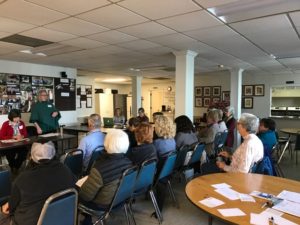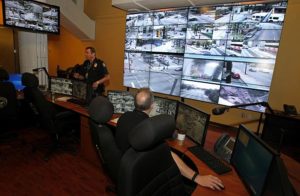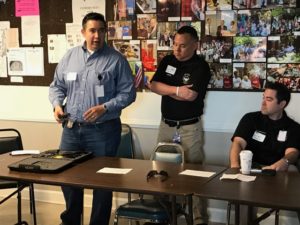Police Reveal Cool Camera Features at VHCA Safety Meeting
And body cameras modify behavior on both sides of the lens
 On Saturday, March 4th at Church of Our Saviour, a good turnout of VaHi safety captains and other interested residents gathered for the annual Safety Captains’ meeting. In attendance were police experts to explain how they are using cameras to fight crime. There was also a discussion led by the VHCA Safety Committee about what residents and businesses can do within our neighborhood to reduce crime.
On Saturday, March 4th at Church of Our Saviour, a good turnout of VaHi safety captains and other interested residents gathered for the annual Safety Captains’ meeting. In attendance were police experts to explain how they are using cameras to fight crime. There was also a discussion led by the VHCA Safety Committee about what residents and businesses can do within our neighborhood to reduce crime.
Street Cameras and Tag Readers
There are now 9 street cameras installed in VaHi, including 3 purchased by VHCA with financial support from Alex Wan. These cameras are the ones that show the blue lights, and they run all the time. There is also a plan to have cameras and lighting all up and down the Beltline.
The Police Foundation’s Video Integration Center has computer monitors that pull up streaming video from street cameras. The purpose is to support first responders and investigations. When there is a 911 call, the 4 closest street cameras are instantly activated. Two can be rewound 5 minutes to help begin an investigation. The real-time ones show what is happening right now—for example, a victim on the ground.
There are also 200 tag readers city-wide. They ping if a suspect car passes them, so police can head over there. These have been very successful and are pretty cool: they snap pictures of tags, transform them to data, upload them to the cloud, and check to see if the owner is wanted. According to the police experts in attendance, there has been a 40% reduction in crime where cameras and tag readers are installed. Blue lights and signs serve to warn would-be criminals that they are under surveillance.
Business and resident cameras
In addition to using the police street cameras, the police Video Integration Center (VIC) can take advantage of business cameras if they are integrated into the system. (This has already happened at Lenox Mall.) Therefore:
- VHCA plans to do a survey of all businesses in the neighborhood to see who has cameras, and what type, to see if they are compatible with the VIC. If not compatible with the VIC, they would be eligible for our registry (see below).
- We will also reach out to residents to see if they are willing to identify theirs—those would not be integrated because of privacy and because home cameras have lower quality than police cameras. But they could be a useful resource, and in some cases already have been.
- Accordingly, VHCA has started a registry (both residential and business) of who already has cameras in the neighborhood. This is a voluntary program: You are not obligated to turn video to police. But they may contact you using the registry if there is an incident near your location.
Anyone interested in helping with this project, or who has a camera, can get in touch with Safety Committee Members Kay Stephenson and Eleanor Barrineau by emailing safety@vahi.org.
Body Cameras
Officer Joseph Mercado of the APD led a discussion and demo of police body cameras, which have now been rolled out in Zone 6. Body cams not only provide transparency, but they serve as a behavior modifier for both ends. Police are able to see how they interact with the public and learn how they could have interacted differently. Also when a person realizes they’re being recorded, it tends to improve the tone of that person when talking to the police.
Zone 6 has had their cameras since the beginning of January. By summer, all officers who answer 911 calls will have body cameras. Officers wear them their entire shift and if they are working off duty (like FBAC) they wear them then as well.
How the body cam video is used. If there is an incident, officers can later enter information into the recording about the incident, which goes into a database that can be part of a wider query later. The hope is to get better prosecution. Video can show the judge that the person has done something multiple times. The judge can see the actual video, not just a report, and this has more impact. Footage cannot be deleted by the officer. The recordings are also encrypted—they only work on supervisors’ docks. So no one can download to their computer. There is an automatic audit trail of who viewed a video and that audit trail can’t be deleted.
A body cam records exactly what the officer sees, so his perspective is what can be demonstrated. If the officer is looking into headlight glare, then that’s what the camera sees, too. There are no filters, by design. It’s a critical part of fairness to show exactly what the officer was seeing. Officers have guidelines on when to turn the body cam on. When an officer activates a body cam, it automatically includes the prior 30 seconds in the recording. In addition, the Police Foundation is currently working with the manufacturer to possibly create a trigger—for example, turning on the police car blue lights could automatically start the camera.
Safety Committee Tips
In the second part of the meeting, the VHCA Safety Chair Eleanor Barrineau led a discussion on Safety Committee Initiatives that we want all residents to be aware of:
1. Lighting. We want to be sure that bikers, pedestrians and people getting in and out of cars are safe. So we are looking to improve lighting in dark areas. On your own street, keep porch lights on. We recommend dusk-to-dawn light bulbs (Home Depot has them—they look like regular light bulbs and screw into a regular light fixture, but they automatically come on at dusk and off at dawn. No timers, no special wiring!). We also encourage you to have driveway lights.
2. Graffiti. If you see any, send to graffiti@vahi.org. Include a picture if possible. Dept of Corrections crews work on those under the supervision of an APD officer. These crews can remove debris as well, such as sometimes appears on Maiden Lane.
3. Event impact. To let neighbors know when events are coming up that affect traffic and parking, the vahi.org calendar at the bottom right of the home page has been expanded to include many different events that could affect traffic. You might even want to participate, knowing an event is going on. In addition, the VHCA safety committee is working to make sure traffic and parking guidelines are enforced during events.
4. Homeowner cameras. Email safety@vahi.org to let them know you have a camera. The Safety Committee can then include these on a registry that police can use.
5. When to call 911 and when to call 311. For any crime, call 911. 311 is very effective for things about which you don’t need immediate police action, such as potholes, leaks in street, street services. You can get a ticket number and their follow-up seems to be good.
About the Police Foundation
Our meeting was attended both by APD and Police Foundation representatives. The Atlanta Police Foundation supports police. It’s a private-public relationship, like the Piedmont Park Conservancy and City of Atlanta- owned Piedmont Park. The Police Foundation runs the Video Integration Center described above, among other initiatives like the Crime Stoppers Program. One of its initiatives is to evaluate police cameras before they are purchased, and help determine how they are used.
Thank You
Our thanks to Michael Faughnan, Sgt. Julio Reyes, and Officers Mercado and Evans of the Atlanta Police Department, and to Marlon Trone, VP of Programs for the Atlanta Police Foundation, who helped make the meeting a success.

